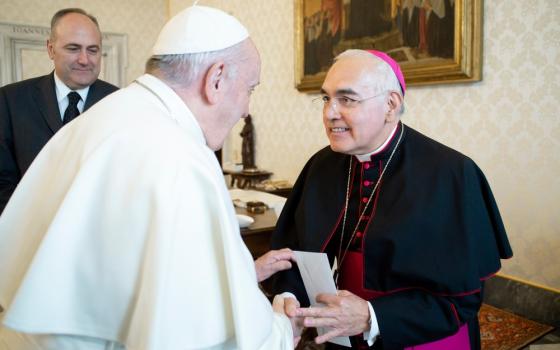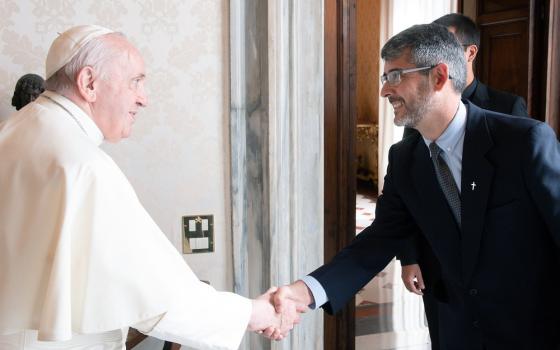Sandra Schneiders is a Sister of the Immaculate Heart of Mary (known to many as the "IHMs") and professor of New Testament Studies and Christian Spirituality at the Jesuit School of Theology of Santa Clara University, in Berkeley, California.
She has written extensively on Religious Life, not only in the National Catholic Reporter, but in her projected three-volume work on Religious Life in the new millennium. The first two volumes were published by Paulist Press in 2000 and 2001 respectively. She is currently working on the third volume.
Schneiders recently published on-line in the NCR an extensive study of Religious Life as a prophetic life form. It ran in five installments from Jan. 4 through Jan. 8. She had previously published a four-page article on Religious Life in the NCR's Oct. 2 issue, and this column subsequently summarized its major points.
Her most recent article is difficult to summarize, but I shall try to do so in this week's and next week's columns. To make the effort as easy to follow as possible, I will simply list some of Schneiders's main points, whether directly or in paraphrase.
- Religious life is a prophetic life form, as Pope John Paul II acknowledged in Vita Conse-crata, a post-synodal apostolic exhortation published in 1996. As such, it is based entirely on Jesus' own prophetic ministry, which called for the end of all domination systems, where power is exercised by the few over the many.
- The current struggle between some in the Vatican and the overwhelming majority of religious communities of women is really a power struggle between those who favor the renewal and reforms promoted by the Second Vatican Council and those who do not. Women's Religious Life is "being used as a symbolic scapegoat" in this confrontation.
- Sisters are a particularly important target because of their sheer numbers and influence. They are also "the largest, best organized, most geographically ubiquitous, most ministerially diversified, and therefore probably most effective promoters of the vision of Vatican II." As such, the Sisters are "the greatest source of hope" for many Catholics, and the "most serious danger" to "the real (that is, pre-conciliar) Church," which others are trying to restore.
- The current investigation of religious communities is confined to communities of women. Male religious communities have declined in numbers just as steeply as women's, but the males are not being investigated. Why is this so?
- Religious Life is also "a charismatic life form, called into existence by the Holy Spirit," which means that its members "live corporately the prophetic charism in the Church." Religious communities, therefore, are not "a work force gathering recruits for ecclesiastical projects," nor is their mission or their particular ministries determined by the hierarchy.
- As for the "shortage" of vocations to Religious Life, "No Congregation 'needs' more members than are actually called to it by God....The purpose of the life is not to perpetuate particular Congregations nor to staff Church institutions; it is to live intensely the witness to the Gospel to which the Congregation is called and for as long as it is called."
- Canon 586, for example, expressly forbids the intrusion by ecclesiastical authorities into the internal affairs of religious communities. They have "a rightful autonomy of life, especially of governance."
- Ministerial innovation by a religious community is not a mark of "instability or infidelity to its originating charism. Such innovation belongs to the nature of the vocation as prophetic rather than institutional."
- The good news of the Kingdom, or Reign, of God applies to the here-and-now, and those who proclaim that good news do so in a compassionate, not judgmental, manner, just as Jesus himself acted when he confronted the religious authorities in defense of the woman caught in adultery (John 8:1-11). Thus, the "ministry of religious to people suffering insoluble conflicts of conscience or caught in impossible life situations, is not rebellion or insubordination but a carefully discerned and courageous fidelity to their primary ministerial vocation: to mediate the good news of God's compassion and justice to people in concrete conditions."
- Sisters are not clerics. Their "non-clerical status...has extremely important implications for their prophetic ministry of which many in the Church are unaware or about which they are ill-informed." A cleric makes a promise of obedience to his ecclesiastical superior and his succes-sors. Religious do not. They make vows to God alone, in the presence of their superiors, to lead the Religious Life. "In the concrete, this means that religious, unlike the clergy, are not agents of the institutional Church as Jesus was not an agent of institutional Judaism."
© 2010 Richard P. McBrien. All rights reserved. Fr. McBrien is the Crowley-O'Brien Professor of Theology at the University of Notre Dame.




